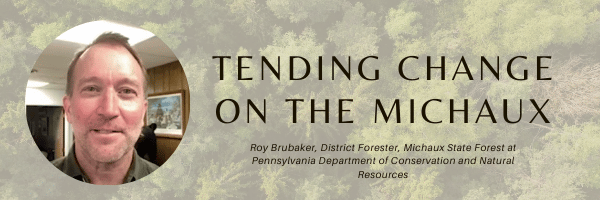Tending Change on the Michaux
The South Mountain Partnership is proud to announce a new communications partnership with the Michaux State Forest, the core of our region and heart of the South Mountain, by bringing you a new perspective straight from the forest in this column written in conjunction with the Michaux District of the Bureau of Forestry and the Friends of Michaux.
February 1st, 2022
We think of forests, particularly publicly managed forests, as places where change should happen slowly, if at all. It’s a comfortably held notion because it aligns a lot of what we know about forests from eighth-grade biology with the fact that many people like their public forests “just the way they are.” People, at both the individual and collective level, have the idea that public forest lands support a broad range of values that can easily be threatened or disrupted by change. The forest might not be perfect. There may be things they wish were done differently – better trails, cleaner restrooms, less paperwork required to get an activity agreement, fewer timber sales, and in general more and better opportunities to discuss their interests and concern about “their” forests with whoever’s “in charge.” If people’s expectations of forests aren’t too severely restricted, disrupted, or trammeled by obvious change, many assume the forest they have now would likely be a whole lot worse if someone fiddled with it too much.
But forests are as dynamic as the society that surrounds them. Particularly one like the Michaux. Mitigating, or lessening, the rate of change on the forest is largely what “those in charge” are doing on a day to day basis. Changing weather conditions and GPS technologies increase winter road use volumes, emergency response needs, and accelerate depreciation of state forest roads. The needs of sharply declining grouse and other residential and migratory bird populations contrast with burgeoning use on “social” mountain biking trails being cut into sensitive bird habitats. An aging ‘boomer’ population and other concerns about the equity of access to forest experiences for those with disabilities introduces new laws and guidelines for the use of motorized or electronic mobility technologies creates challenges between individuals and across user groups which ultimately require response and mitigation at the forest level by “those in charge.” Yet for most, these kinds of dynamics aren’t perceived as forest change. Certainly not anything as drastic as, say. . .a logging job!
For those of us who work on the Michaux, participating in the day to day changes of the forest is inevitable. There are changes we’d like to see happen and would work our fingers to the bone to bring to fruition if we just knew how. There are changes or potential changes that terrify us, but we don’t know how to stop them. (Who wants to be a forester on the Michaux in the decade when the state bird and state fish get extirpated from its streams and streamside forests?) We don’t always know how to include the incredible community of friends and supporters around us into that work as effectively as we need to.
So as part of our ongoing engagement with the South Mountain Partnership, we would like to introduce a quarterly contribution tho this newsletter that will explore the theme of change on the Michaux. Our idea is that we would use this column to communicate the changes Michaux staff are grappling with on a seasonal and “real time” basis. Hopefully, it will also serve to gather your ideas and sustain a conversation with you and the SMP on topics of change.
The title for this column; “Tending Change on the Michaux,” is intentionally chosen. Tending is more than participating or embracing. It’s at once more assertive and prescriptive, and yet simpler to understand. It conveys a sense of active directionality. It brings to mind words like Attention, Intentional, Caring, Tender. If we tend the change on the Michaux together, we stand the best possible chance of sustaining the forest itself. But we need to do so with the intention of envisioning and then working to bring about desired future forest conditions that will only be possible if we work together to make them so.

